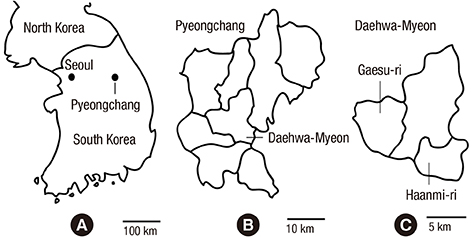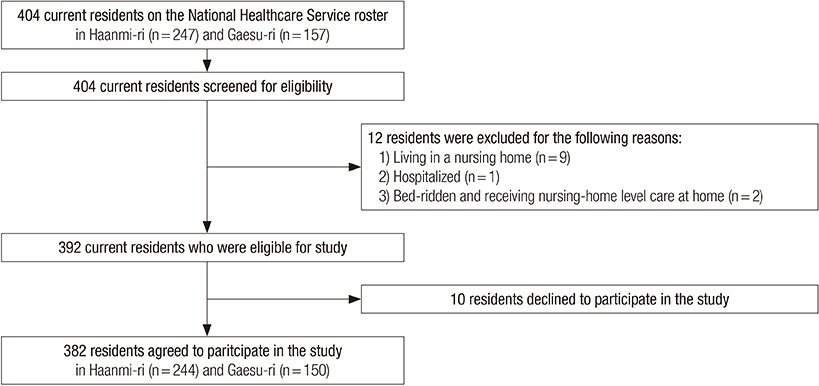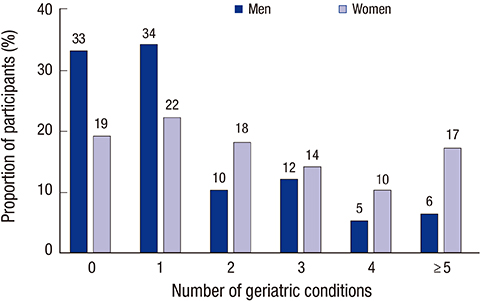J Korean Med Sci.
2016 Mar;31(3):345-352. 10.3346/jkms.2016.31.3.345.
Prevalence of Frailty and Aging-Related Health Conditions in Older Koreans in Rural Communities: a Cross-Sectional Analysis of the Aging Study of Pyeongchang Rural Area
- Affiliations
-
- 1Graduate School of Medical Science and Engineering, Korea Advanced Institute of Science and Technology (KAIST), Daejeon, Korea.
- 2Department of Internal Medicine, Pyeongchang Health Center & County Hospital, Pyeongchang, Korea.
- 3Department of Internal Medicine, Asan Medical Center, University of Ulsan College of Medicine, Seoul, Korea. eunjulee@amc.seoul.kr
- 4Department of Urology, Pyeongchang Health Center & County Hospital, Pyeongchang, Korea.
- 5Community Health Post, Pyeongchang Health Center & County Hospital, Pyeongchang, Korea.
- 6Manager of Public Health, Pyeongchang Health Center & County Hospital, Pyeongchang, Korea.
- 7Division of Gerontology, Department of Medicine, Beth Israel Deaconess Medical Center, Harvard Medical School, Boston, MA, USA.
- KMID: 2363493
- DOI: http://doi.org/10.3346/jkms.2016.31.3.345
Abstract
- Frailty has been previously studied in Western countries and the urban Korean population; however, the burden of frailty and geriatric conditions in the aging populations of rural Korean communities had not yet been determined. Thus, we established a population-based prospective study of adults aged > or = 65 years residing in rural communities of Korea between October 2014 and December 2014. All participants underwent comprehensive geriatric assessment that encompassed the assessment of cognitive and physical function, depression, nutrition, and body composition using bioimpedance analysis. We determined the prevalence of frailty based on the Cardiovascular Health Study (CHS) and Korean version of FRAIL (K-FRAIL) criteria, as well as geriatric conditions. We recruited 382 adults (98% of eligible adults; mean age: 74 years; 56% women). Generally, sociodemographic characteristics were similar to those of the general rural Korean population. Common geriatric conditions included instrumental activity of daily living disability (39%), malnutrition risk (38%), cognitive dysfunction (33%), multimorbidity (32%), and sarcopenia (28%), while dismobility (8%), incontinence (8%), and polypharmacy (3%) were less common conditions. While more individuals were classified as frail according to the K-FRAIL criteria (27%) than the CHS criteria (17%), the CHS criteria were more strongly associated with prevalent geriatric conditions. Older Koreans living in rural communities have a significant burden of frailty and geriatric conditions that increase the risk of functional decline, poor quality of life, and mortality. The current study provides a basis to guide public health professionals and policy-makers in prioritizing certain areas of care and designing effective public health interventions to promote healthy aging of this vulnerable population.
Keyword
MeSH Terms
-
Activities of Daily Living
Aged
Aged, 80 and over
*Aging
Body Composition
Cognition Disorders/epidemiology
Cross-Sectional Studies
Demography
Disabled Persons
Female
Geriatric Assessment/*statistics & numerical data
*Health Status
Humans
Interviews as Topic
Male
Prevalence
Quality of Life
Republic of Korea/epidemiology
Rural Population
Sarcopenia/epidemiology
Figure
Cited by 1 articles
-
Frailty and elderly in urology: implications for postoperative complications
Phil Hyun Song
Yeungnam Univ J Med. 2020;37(4):296-301. doi: 10.12701/yujm.2020.00752.
Reference
-
1. Organisation for Economic Co-operation and Development. OECD Economic Surveys: Korea 2012. Paris: OECD Publishing;2012. p. 17.2. Statistics Korea. National statistical database. Statistics Korea 2014. Daejeon: Statistics Korea;2015.3. Jung HW, Kim KI. Multimorbidity in older adults. J Korean Geriatr Soc. 2014; 18:65–71.4. Fried LP, Tangen CM, Walston J, Newman AB, Hirsch C, Gottdiener J, Seeman T, Tracy R, Kop WJ, Burke G, et al. Frailty in older adults: evidence for a phenotype. J Gerontol A Biol Sci Med Sci. 2001; 56:M146–56.5. Clegg A, Young J, Iliffe S, Rikkert MO, Rockwood K. Frailty in elderly people. Lancet. 2013; 381:752–762.6. Collard RM, Boter H, Schoevers RA, Oude Voshaar RC. Prevalence of frailty in community-dwelling older persons: a systematic review. J Am Geriatr Soc. 2012; 60:1487–1492.7. Jung HW, Kim SW, Ahn S, Lim JY, Han JW, Kim TH, Kim KW, Kim KI, Kim CH. Prevalence and outcomes of frailty in Korean elderly population: comparisons of a multidimensional frailty index with two phenotype models. PLoS One. 2014; 9:e87958.8. Gill TM. Disentangling the disabling process: insights from the precipitating events project. Gerontologist. 2014; 54:533–549.9. Lee EY, Kim HC, Rhee Y, Youm Y, Kim KM, Lee JM, Choi DP, Yun YM, Kim CO. The Korean urban rural elderly cohort study: study design and protocol. BMC Geriatr. 2014; 14:33.10. United Nations, Department of Economic and Social Affairs. World urbanization prospects: the 2014 revision. New York, NY: United Nations;2014. p. 3.11. Jeon GS, Cho SH. Prevalence and social correlates of frailty among rural community-dwelling older adults. J Korean Geriatr Soc. 2014; 18:143–152.12. Chun JD, Ryu SY, Han MA, Park J. Comparisons of health status and health behaviors among the elderly between urban and rural areas. J Agric Med Community Health. 2013; 38:182–194.13. Lee CY, Cho YH. Evaluation of a community health practitioner self-care program for rural Korean patients with osteoarthritis. J Korean Acad Nurs. 2012; 42:965–973.14. Kim Y. The Korea National Health and Nutrition Examination Survey (KNHANES): current status and challenges. Epidemiol Health. 2014; 36:e2014002.15. Kang Y, Na DL, Hahn S. A validity study on the Korean Mini-Mental State Examination (K-MMSE) in dementia patients. J Korean Neurol Assoc. 1997; 15:300–308.16. Choe MA, Kim J, Jeon MY, Chae YR. Evaluation of the Korean version of Physical Activity Scale for the Elderly (K-PASE). Korean J Women Health Nurs. 2010; 16:47–59.17. Chen LK, Liu LK, Woo J, Assantachai P, Auyeung TW, Bahyah KS, Chou MY, Chen LY, Hsu PS, Krairit O, et al. Sarcopenia in Asia: consensus report of the Asian working group for sarcopenia. J Am Med Dir Assoc. 2014; 15:95–101.18. Cummings SR, Studenski S, Ferrucci L. A diagnosis of dismobility--giving mobility clinical visibility: a Mobility Working Group recommendation. JAMA. 2014; 311:2061–2062.19. Won CW, Yang KY, Rho YG, Kim SY, Lee EJ, Yoon JL, Cho KH, Shin HC, Cho BR, Oh JR, et al. The development of Korean Activities of Daily Living (K-ADL) and Korean Instrumental Activities of Daily Living (K-IADL) scale. J Korean Geriatr Soc. 2002; 6:107–120.20. Radloff LS. The CES-D scale a self-report depression scale for research in the general population. Appl Psychol Meas. 1977; 1:385–401.21. Park JH, Kim KW. A review of the epidemiology of depression in Korea. J Korean Med Assoc. 2011; 54:362–369.22. Rubenstein LZ, Harker JO, Salvà A, Guigoz Y, Vellas B. Screening for undernutrition in geriatric practice: developing the short-form mini-nutritional assessment (MNA-SF). J Gerontol A Biol Sci Med Sci. 2001; 56:M366–72.23. Morley JE, Malmstrom TK, Miller DK. A simple frailty questionnaire (FRAIL) predicts outcomes in middle aged African Americans. J Nutr Health Aging. 2012; 16:601–608.24. Jung HW, Yoo HJ, Park SY, Kim SW, Choi JY, Yoon SJ, Kim CH, Kim KI. The Korean version of the FRAIL scale: clinical feasibility and validity of assessing the frailty status of Korean elderly. Korean J Intern Med. Forthcoming. 2015.25. Kim JH, Choi SH, Lim S, Kim KW, Lim JY, Cho NH, Park KS, Jang HC. Assessment of appendicular skeletal muscle mass by bioimpedance in older community-dwelling Korean adults. Arch Gerontol Geriatr. 2014; 58:303–307.26. Curcio CL, Henao GM, Gomez F. Frailty among rural elderly adults. BMC Geriatr. 2014; 14:2.27. Woo J, Goggins W, Sham A, Ho SC. Social determinants of frailty. Gerontology. 2005; 51:402–408.28. Kim CO, Lee KR. Preventive effect of protein-energy supplementation on the functional decline of frail older adults with low socioeconomic status: a community-based randomized controlled study. J Gerontol A Biol Sci Med Sci. 2013; 68:309–316.
- Full Text Links
- Actions
-
Cited
- CITED
-
- Close
- Share
- Similar articles
-
- Prevalence and Social Correlates of Frailty Among Rural Community-Dwelling Older Adults
- The Aging Study of Pyeongchang Rural Area (ASPRA): Findings and Perspectives for Human Aging, Frailty, and Disability
- Discrepancies in the Prevalence of Known Frailty Scales: Korean Frailty and Aging Cohort Study
- Urban-Rural Differences in Prevalence of Depressive Symptoms and Its Related Factors Among Older Adults: Findings from the Korean Longitudinal Study of Aging
- Association of the FRAIL Scale with Geriatric Syndromes and Health-Related Outcomes in Korean Older Adults




